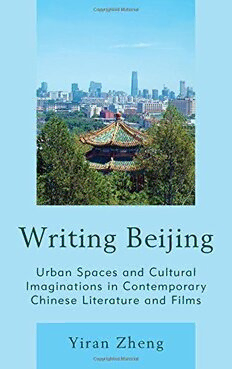
Writing Beijing: Urban Spaces and Cultural Imaginations in Contemporary Chinese Literature and Films PDF
Preview Writing Beijing: Urban Spaces and Cultural Imaginations in Contemporary Chinese Literature and Films
Writing Beijing Writing Beijing Urban Spaces and Cultural Imaginations in Contemporary Chinese Literature and Films By Yiran Zheng LEXINGTON BOOKS Lanham • Boulder • New York • London Published by Lexington Books An imprint of The Rowman & Littlefield Publishing Group, Inc. 4501 Forbes Boulevard, Suite 200, Lanham, Maryland 20706 www.rowman.com Unit A, Whitacre Mews, 26-34 Stannary Street, London SE11 4AB Copyright © 2016 by Lexington Books Quotes from Wild Beast, Could Be Beautiful, I Am Your Father, Mr. Xu, and Air Hostess by Wang Shuo reprinted by permission of Beijing Shiyue Wenyi Press. “This is Beijing at 4:08” by Shi Zhi, originally published in Shi Zhi’s Poems. Reprinted by permission of Renmin Wenxue Press Ltd. Quotes from How Far is Eternity by Tie Ning reprinted by permission of Tie Ning. All rights reserved. No part of this book may be reproduced in any form or by any electronic or mechanical means, including information storage and retrieval systems, without written permission from the publisher, except by a reviewer who may quote passages in a review. British Library Cataloguing in Publication Information Available Library of Congress Cataloging-in-Publication Data Names: Yiran, Zheng, 1978, author. Title: Writing Beijing : urban spaces and cultural imaginations in contemporary Chinese literature and films / Yiran Zheng. Description: Lanham, Maryland : Lexington Books, 2016. | Includes bibliographical references and index. Identifiers: LCCN 2016001246 (print) | LCCN 2016012613 (ebook) | ISBN 9781498531016 (cloth : alk. paper) | ISBN 9781498531023 (Electronic) Subjects: LCSH: Chinese literature—20th century—History and criticism. | Chinese literature—21st century—History and criticism. | Motion pictures, Chinese—History and criticism. | Beijing (China)—In literature. | Public spaces in literature. | Public spaces—China—Beijing. | China—In motion pictures. Classification: LCC PL2275.P42 Y57 2016 (print) | LCC PL2275.P42 (ebook) | DDC 895.109/35851156—dc23 LC record available at http://lccn.loc.gov/2016001246 ™ The paper used in this publication meets the minimum requirements of American National Standard for Information Sciences—Permanence of Paper for Printed Library Materials, ANSI/NISO Z39.48-1992. Printed in the United States of America Contents Figures vii Introduction ix Part I Chapter 1 W ork Unit Compound: An Emergence of a New Urban Space 3 Chapter 2 “Gongheguo xingui” (New Aristocrats of the PRC) 11 Chapter 3 R ed Nostalgia in the Literature of the Military Compound 19 Part II Chapter 4 S iheyuan: Signifier of Traditional and Masculine City 49 Chapter 5 Second-Generation Beijing Flavor Writers 57 Chapter 6 T raditional Beijing and Masculine Beijing in Second-Generation Beijing Flavor Literature 63 Part III Chapter 7 M odern and Postmodern Architectures: Presentations of the Global Context 89 v vi • Contents Chapter 8 Beijing Floaters 107 Chapter 9 C osmopolitan Metropolis as an Urban Dream in Sixth-Generation Films 113 Conclusion 127 References 131 Index 141 About the Author 149 Figures Figure I.1. Framework of methodology xiii Figure 1.1. A typical Beijing hutong at wudaoying 7 Figure 4.1. A three-jin siheyuan composed of three conjoined yards 52 Figure 4.2. Corner of a siheyuan 53 Figure 6.1. Turret and the city wall of the Forbidden City 68 Figure 7.1. A townhouse named “British Castle” in a suburb of Beijing 93 Figure 7.2. Houses named “British Castle” and high apartment buildings named “British Palace” 93 Figure 7.3. Beijing West Railway Station 95 Figure 7.4. The China Millennium Monument 96 Figure 7.5. Starbucks at Shichahai 98 Figure 7.6. National Centre for the Performing Arts (the Giant Egg) 100 Figure 7.7. National Stadium (the Bird’s Nest) 100 Figure 7.8. CCTV New Main Building (the Gate) 101 Figure 7.9. Scene of the Central Business District 104 vii Introduction On August 8, 2008, the fireworks launched from Beijing National Stadium illuminated the capital’s night sky. Beijing had successfully hosted the twenty-ninth Olympiad and welcomed a million foreign guests. When tour- ists first see Beijing, many stereotypes get shattered. They discover that the city is not one in which high walls divide imperial palaces from poor shelters. It is not a city of rickshaws clattering down narrow and dirty streets. It is not a city of blue or gray uniforms and political fanaticism. They see instead re- painted old wooden buildings and skyscrapers with shining glass shells. They see Beijing as a presentation, a symbol of the fusion of a “traditional” Chinese city and a modern international metropolis. As one of the oldest cities in the world, Beijing’s history can be traced back to 3,000 years ago. Serving as the capital city during Yuan, Ming, and Qing, the last three imperial dynasties, Beijing witnessed China’s greatest power and prosperity. Since the People’s Republic of China (PRC) was founded, Beijing became the political center of the new communist country which dramatically changed its image both physically and culturally as the city was transformed into the signifier of socialist ideology and revolutionary culture. Then, at the turn of the twenty-first century, Beijing was forced to face once again the contradiction between nationalism and modernization and to deal with the difficult integration between what is “Chinese” and what is “Western”; the city space has thus become one of the focal points for showcasing socioeconomic problems in a global context. The difficulties in confronting these challenges are representative of that of many Chinese ix
